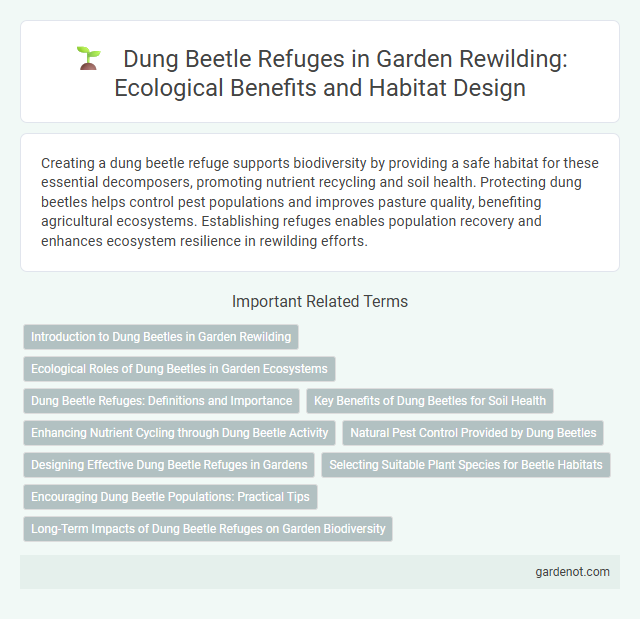Creating a dung beetle refuge supports biodiversity by providing a safe habitat for these essential decomposers, promoting nutrient recycling and soil health. Protecting dung beetles helps control pest populations and improves pasture quality, benefiting agricultural ecosystems. Establishing refuges enables population recovery and enhances ecosystem resilience in rewilding efforts.
Introduction to Dung Beetles in Garden Rewilding
Dung beetles play a crucial role in garden rewilding by breaking down animal waste, enhancing soil fertility, and promoting nutrient cycling. Their activity supports plant growth and increases biodiversity by aerating soil and reducing pests. Establishing dung beetle refuges in gardens fosters a self-sustaining ecosystem essential for natural regeneration and ecological balance.
Ecological Roles of Dung Beetles in Garden Ecosystems
Dung beetle refuges enhance soil health by accelerating organic waste decomposition and nutrient cycling, promoting plant growth and biodiversity within garden ecosystems. These insects reduce pest populations by removing animal feces, thereby limiting breeding grounds for harmful parasites and flies. Their burrowing activity improves soil aeration and water infiltration, contributing to a more resilient and sustainable garden environment.
Dung Beetle Refuges: Definitions and Importance
Dung beetle refuges are protected habitats specifically designed to conserve and support populations of dung beetles, essential decomposers in ecosystems. These refuges enhance nutrient recycling, soil aeration, and the control of pests by providing safe environments free from chemical pollutants and habitat destruction. Preserving dung beetle diversity within these refuges strengthens ecosystem resilience and promotes biodiversity restoration in rewilding projects.
Key Benefits of Dung Beetles for Soil Health
Dung beetle refuges significantly enhance soil health by accelerating nutrient cycling through the rapid decomposition of animal waste, which enriches soil fertility. Their burrowing activities improve soil aeration and water infiltration, reducing compaction and promoting robust root growth. These processes contribute to increased microbial diversity and soil structure stability, essential for sustainable ecosystem functioning.
Enhancing Nutrient Cycling through Dung Beetle Activity
Dung beetle refuges play a crucial role in enhancing nutrient cycling by accelerating the decomposition of animal feces, which enriches soil fertility and promotes plant growth. Their burrowing and tunneling actions aerate the soil, improving water infiltration and nutrient distribution essential for ecosystem health. Intensive dung beetle activity reduces harmful parasites and greenhouse gases, contributing to sustainable pasture management and climate mitigation.
Natural Pest Control Provided by Dung Beetles
Dung beetle refuges significantly enhance natural pest control by efficiently breaking down livestock manure, which reduces breeding sites for harmful flies and parasites. These beetles accelerate nutrient cycling, promoting healthier soil and vegetation that support diverse ecosystems. Establishing protected habitats for dung beetles fosters sustainable agricultural practices and minimizes the need for chemical pesticides.
Designing Effective Dung Beetle Refuges in Gardens
Designing effective dung beetle refuges in gardens involves creating habitats that mimic natural ecosystems with ample organic matter and undisturbed soil layers, essential for beetle lifecycle stages like larval development. Incorporating native plant species and maintaining moist, shaded areas enhance microhabitat quality, promoting dung beetle biodiversity and ecological functions such as nutrient recycling and soil aeration. Strategic placement of refuges near livestock or compost zones maximizes dung availability, supporting population sustainability and strengthening garden ecosystem health.
Selecting Suitable Plant Species for Beetle Habitats
Selecting native flowering plants that provide ample pollen and nectar supports dung beetle nutrition and reproduction. Incorporating a diversity of grasses, legumes, and shrubs creates microhabitats essential for dung beetle shelter and larval development. Emphasizing plant species that improve soil structure enhances dung decomposition and promotes a thriving beetle refuge ecosystem.
Encouraging Dung Beetle Populations: Practical Tips
Creating a dung beetle refuge involves maintaining livestock grazing areas with minimal pesticide use, ensuring a continuous supply of undisturbed dung for beetles to thrive. Incorporating native plant species in pasturelands supports beetle habitats by enhancing soil moisture and organic matter necessary for larvae development. Regular monitoring and habitat connectivity between refuges improve population resilience and promote effective nutrient recycling in rewilded ecosystems.
Long-Term Impacts of Dung Beetle Refuges on Garden Biodiversity
Dung beetle refuges play a crucial role in enhancing garden biodiversity by improving soil health through nutrient recycling and aeration, which supports diverse plant growth. These refuges promote a balanced ecosystem by fostering beneficial insect populations and reducing pest outbreaks naturally. Over time, the presence of dung beetles increases organic matter decomposition rates, leading to sustained habitat quality and resilience in garden environments.
Dung beetle refuge Infographic

 gardenot.com
gardenot.com